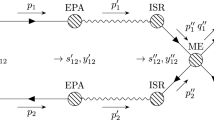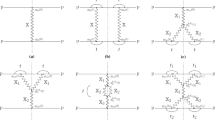Abstract
For historical reasons, FLUKA is best known for its hadron event generators: but the present version of the code can handle with similar or better accuracy also muons, low energy neutrons and electromagnetic effects. And, most important of all, it can simulate the transport of all these radiation components and their reciprocal interactions at the same time. This capability is especially important in accelerator shielding and in cosmic ray studies where the cross-talk at all energies between the different components is very complex and essential for an understanding of the radiation field.
Access this chapter
Tax calculation will be finalised at checkout
Purchases are for personal use only
Preview
Unable to display preview. Download preview PDF.
Similar content being viewed by others
References
P.A. Aarnio et al.: In Proc. MC93 Int. Conf., Tallahassee 1993. Ed. P. Dragovitsch, S.L. Linn and M. Burbank (World Scientific, Singapore 1994) p. 100
L. Kim et al: Phys. Rev. A 33, 3002 (1986)
S.M. Seltzer, M.J. Berger: At. Data Nucl. Data Tab. 35, 345 (1986)
F. Sauter: Ann. der Phys. 9, 217 (1931); 9, 454 (1931)
A. Fassö, A. Ferrari, J. Ranft, P.R. Sala: Proc. SARE3 Workshop, Ed. H. Hirayama, KEK Proceedings 97-5 (1997)
A. Ferrari et al.: Nucl. Instr. Meth. in Phys. Res. B 71, 412 (1992)
I. Kawrakow, A.F. Bielajew: Nucl. Instr. Meth. B 142, 253 (1998)
H. Drescher et al.: Z. Angew. Phys. 29, 331 (1970)
Author information
Authors and Affiliations
Editor information
Editors and Affiliations
Rights and permissions
Copyright information
© 2001 Springer-Verlag Berlin Heidelberg
About this paper
Cite this paper
Fassò, A., Ferrari, A., Sala, P.R. (2001). Electron-Photon Transport in FLUKA: Status. In: Kling, A., Baräo, F.J.C., Nakagawa, M., Távora, L., Vaz, P. (eds) Advanced Monte Carlo for Radiation Physics, Particle Transport Simulation and Applications. Springer, Berlin, Heidelberg. https://doi.org/10.1007/978-3-642-18211-2_27
Download citation
DOI: https://doi.org/10.1007/978-3-642-18211-2_27
Publisher Name: Springer, Berlin, Heidelberg
Print ISBN: 978-3-642-62113-0
Online ISBN: 978-3-642-18211-2
eBook Packages: Springer Book Archive




